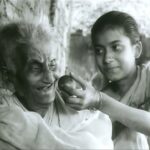Synopsis of the play
A boy of fifteen, Kanaichand does not prefer ‘study’ to playing football. Therefore, his parents remain always helpless with his ‘progress report’. Being fatigued of son’s ‘performances’, the father compelled Kanai to join the Indian Army. And there the boy could understand that the life is nothing but a trick. It is a game, and we have to play it.
Fortunately, he made a move and became the ‘National Hero’ by fluke. Therefore, the responsibility reaches to its peak. Government sent him to solve question in another front.
Unfortunately, some sharp worm bullets touched his heart. Kanai became a ‘Martyr’ for the nation, leaving trails of questions on the futility of war, on the compulsory rat race in parents’ mind, on the role of Father Figures in our extended society, and so on.
Thus goes the story on, and unfolds the fact that the whole story has been dreamt simultaneously by the parents. The trance of nightmare is broken with the triumphant come back of ‘footballer’ Kanaichand. The drama ends happily, but the questions remain alive.
Director's Note
The play, Kanaichand Palowan allows us to form a new kind of theatre on the square of proscenium. Besides, the play denotes a point of crisis from which a child coming from a middle class family always suffers. The play can seem to be a pedagogue, as we deliberately want to lead its messages straight to the kids, as well as to their elder counterparts, the guardians. And to make the world a better place to live in, as we dream, children will shoulder the prime responsibility.
The more we teach, the more we learn. This is the prime attitude behind our effort. Therefore, we have started doing or having regular workshops with theatre workers of different ages: from six to sixty. To the extent of experiment, we are putting the children in major roles. This is not only to look the work through an opposite angle, but to destroy the bars between kids and elders, also. Moreover, to create a democratic bridge between urchins and us, the so-called ‘civilized’ elders. We truly need to learn from them, we really have to trust them. To touch the unexplored field of our practice, where both the kids and elders are performing, children are chosen as the target audience. Besides, if the parents can also understand the necessity of the said ‘bridge’ our effort would gain the optimum success.
Apart from all this, to nourish our creative self we have decided to work with ‘Nonsense’ as it smarts out our sense to the great extent of humanity. Our previous production ‘Furrut: A Theatre for Children’ has proved our mettle in this context. The concerned production is being designed with comic clothing having the laces of the same essence of ‘Nonsense’.
Sharing the truth, as the great Stanislavski goes on, that an actor should love the art in him/herself and should not him/herself in the art, we, throughout this six-month-progression, have just enchanted only one thing: the process is important , not the actors. Though we have had a pack of good actors, yet often the process has made them and vice versa.
The play, ‘Kanaichand Palowan’ is being seen thorough a different angle where children are playing the role of elders, the persons who usually rule / wish to rule the home & world. And the elders are playing the role of kids. There is ample scope of experiment with the ‘age’, which we have taken. The child actors are always a trouble for the elders. So, the chemistry between the actors of the two radically different age groups has challenged the production. And we have successfully withstood the challenge.
The play has taken the form of traditional Indian folk style where someone is narrating the story. This form had been very popular as the same of Bertolt Brecht has worked with. Epic technique of Brecht has been drawn from his study on the cultural habits of Indian folks, their performing rituals and rites. The narrative style of story telling is an ancient form of our heritage. Our great epics like Mahabharata & Ramayana are composed in this style. In the play, we have enhanced the timber of folk tune by mixing yet another folk art of rural Bengal, which is Jari Gaan. A pir / fakir /Gaji (bard singing, basically, the devotional songs on Islam) moves around singing the story of some hero or heroic deeds. Nowadays, the form is being utilized, by Government in different welfare movements, to respond against the social stigmas. We just incorporated the form to tell the story more interestingly so that the message can communicate people easily & musically.
We have learnt from different workshops on folk form and folk acting. The place given by Niva Arts has endowed us with full comfort and freedom to work on. The actors, the musicians, the resource persons have taken excessive load to accomplish the task. Now, if the children can find a domain of happiness that leads them to a good lesson and so to their elder counterparts, our endeavor would get its reward.
Drama, Set, Music, Design & Direction
Raja Bhattacharya



